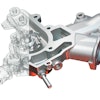
 Jack Payne, VP, Product Management & Solutions Consulting, Aptean
Jack Payne, VP, Product Management & Solutions Consulting, ApteanMost food and beverage manufacturers have invested in an Enterprise Resource Planning (ERP) system, and many have integrated their ERP with a number of other solutions such as Warehouse Management System (WMS), Customer Relationship Management (CRM), Manufacturing Execution System (MES) and Enterprise Asset Management (EAM). Organizations looking to become market leaders often consider expanding the scope of these systems outside of their organization in order to obtain more value and improve the relationships with their customers and suppliers.
Offering an Enterprise Portal is an efficient way for manufacturers to communicate with their customers and suppliers 24/7 while increasing brand equity and remaining competitive. The main challenge with deploying an Enterprise Portal is balancing the availability of timely and critical internal enterprise data with security, so that only those authorized gain access to the information. As these portals typically pull information directly from the ERP, WMS and CRM systems, each Enterprise Portal user is provided the right data at the right time, resulting in an optimal online experience.
Various factors have led to the increased demand for online access. The number of American consumers who shop online has increased dramatically over the past fifteen years, with almost 80 percent of all consumers making purchases on the web in 2016, up from just 22 percent in 2000. This preference is extending into the business-to-business (B2B) market as well. According to industry research, 80 percent of B2B buyers prefer suppliers who offer a more user-friendly web presence, and 75 percent of buyers have shopped at an e-marketplace, up from just 20 percent in 2013. While the trend is seen across generations, the majority of Gen X and Millennials prefer to shop online rather than in-store. As Millennials enter the workforce, these expectations are coming with them. In fact, “customer experience” is expected to overtake “price” and “product quality” as the most important buying decision criteria by 2020.
Self-Service is Expected
In years past, the majority of all purchasing-related business was conducted by phone or via email. With advances in technology, Electronic Data Interchange (EDI) became widely adopted as large numbers of multi-line purchase orders could be transmitted and accepted within minutes with little error. However, EDI lacks on-line interaction, being limited to “Send” and “Receive” with significant time gaps. In addition, the resolution of “requests for change” via EDI are cumbersome and usually require human intervention. The majority of B2B customers prefer self-service to the complexity of explaining what they need and when they need it, and they want immediate feedback. An Enterprise Portal brings that element of self-service to reality, allowing a secure and efficient way to “give and receive” information that bypasses lengthy phone queues, long email strings or multiple EDI interactions. This is not to say that the Enterprise Portal will replace EDI, as a need remains for high volume transmission of data. Instead, the Enterprise Portal augments EDI as a means to provide interactive and real-time information to both customers and suppliers.
The Enterprise Portal is not just an order-taking vehicle, but also is a way to give customers and suppliers what they need, when they need it and in their preferred format. Rather than calling to get a copy of an invoice or request the status of order, the Enterprise Portal, integrated with the various enterprise systems, supplies the answer. This portal also enables buyers to perform their daily activities (search a catalog, save favorite SKUs, verify pricing) at their convenience. The ERP integration ensures that the price points and product availability presented online match the customer’s contract and the supplier’s current inventory availability status. Self-service web-based invoicing and payment platforms may also be added, and are increasingly important in delivering exceptional levels of customer service. Most people are used to online payments in their personal business and expect the same convenience and efficiency when paying business invoices.
Routine and repetitive administrative tasks are at the top of what most buyers and sellers list as taking the most time away from strategic sourcing decisions. By providing efficient and accurate self-service capabilities, account managers and support staff have more time to proactively collaborate on more meaningful conversations about their long-term partner relationships.
Collaboration is Essential
In addition to minimizing the time needed to execute support tasks, the Enterprise Portal can be a great place for customers and suppliers to access a tailored knowledge base of marketing and educational material, company policies and FAQs. By furnishing personalized content for the user, the organization is perceived as a valued partner rather than a mere customer or supplier.
The Enterprise Portal also enhances the company’s ability to prepare custom quotes that contain only relevant products with verified availability and accurate pricing. By tracking portal user behavior online, internal marketing and sales can better segment the customer base for tailored sales campaigns and more timely marketing messages. Online access also provides an immediate feedback mechanism for customers and suppliers to suggest a process improvement. The key message that an efficient and integrated Enterprise Portal presents is that “we are in business together”.
Conclusion
In a high-volume/low-margin industry such as food and beverage, manufacturers need to be constantly reducing costs while providing ever-increasing levels of customer and supplier service. An Enterprise Portal, when properly designed and deployed, is an efficient means to do both.
The self-service aspect satisfies today’s need for providing the user with what they want and when they want it, while freeing up internal support staff to focus more on complex issues and less on routine tasks. Companies that offer Enterprise Portals routinely see their gross margins improve as the integration with their enterprise systems means fewer pricing errors and a reduction of overall Selling and General Administration (SG&A) expense. Providing the ability to make online payments also improves cash flow as electronic payments are immediately credited and less likely to be misapplied. The added benefit of a knowledge base within the portal also elevates the ease of doing business with your company and improves the likelihood of repeat business.
In short, deploying an Enterprise Portal for your customers and suppliers may seem like an innovative solution today; however, with the Millennials entering the workforce as the Baby Boomers retire, it will shortly become a requirement.
Jack Payne is VP, Product Management & Solutions Consulting for Aptean





















